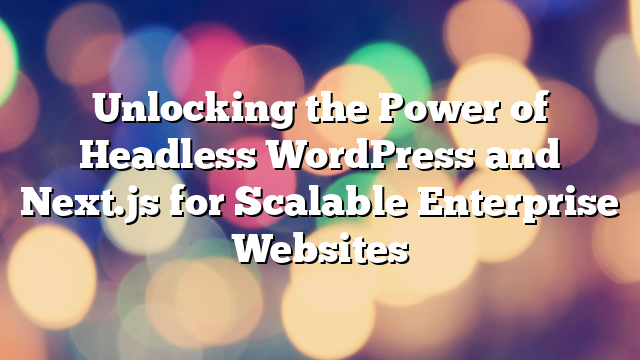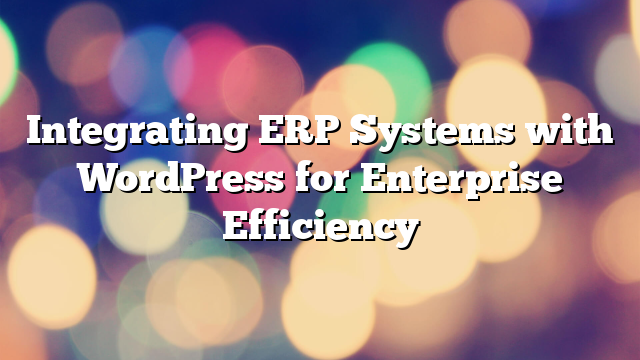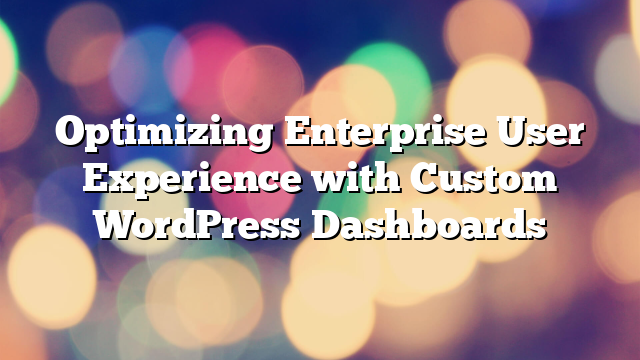Unlocking the Power of Headless WordPress and Next.js for Scalable Enterprise Websites
03.05.2025

As digital experiences evolve, enterprises are increasingly looking for more flexible, high-performing solutions for their websites. Traditional WordPress websites often struggle to meet the scalability and performance demands of larger organizations. However, by combining the power of WordPress with Next.js in a headless architecture, companies can create fast, secure, and easily scalable websites that meet modern digital demands. This article explores how the headless approach with WordPress and Next.js can be a game-changer for enterprises.
What is Headless WordPress?
Headless WordPress is a modern architecture where WordPress is used solely as a content management system (CMS) while the front-end of the website is powered by other technologies, such as Next.js. In this setup, WordPress is decoupled from the frontend, allowing businesses to leverage the full potential of WordPress for content management while using powerful front-end technologies like Next.js for optimal user experiences and performance.
The WordPress REST API or GraphQL can be used to fetch content from WordPress, which is then rendered on the frontend using Next.js. This enables faster load times, more flexibility in design, and improved overall site performance.
Benefits of Combining WordPress with Next.js
Integrating WordPress as a headless CMS with Next.js brings a range of benefits to enterprise websites:
- Improved Performance: Next.js allows static site generation (SSG) and server-side rendering (SSR), which results in significantly faster load times. Static pages are pre-rendered and served quickly, ensuring that content is accessible immediately, without delays.
- Scalability: The headless approach separates the backend from the frontend, meaning both can be scaled independently. Next.js can handle high traffic volumes, while WordPress focuses on content management. This scalability is critical for enterprise websites with heavy traffic or complex content needs.
- Enhanced Flexibility: The separation of the frontend and backend allows greater flexibility in the design and technology used. Developers are no longer bound by WordPress themes or templates, and they can build customized user interfaces with React and other tools provided by Next.js.
- Better Security: With WordPress acting only as a CMS and the frontend decoupled, security vulnerabilities often associated with WordPress themes and plugins are reduced. By relying on Next.js for the frontend, you minimize the attack surface, improving the security posture of the website.
- Improved SEO: With Next.js, pages are server-side rendered (SSR) or statically generated, meaning that search engines can crawl and index content more easily, leading to better SEO rankings.
How WordPress and Next.js Work Together
The integration process between WordPress and Next.js is relatively simple, thanks to the WordPress REST API or GraphQL. Here’s how the workflow typically goes:
- Install WordPress and Enable the REST API: Begin by setting up WordPress as a headless CMS. This involves installing WordPress and enabling its REST API, which allows external applications to fetch content from WordPress.
- Set Up Next.js for the Frontend: With Next.js, create a frontend that interacts with the WordPress backend through the REST API. Next.js allows developers to use React components and static generation techniques for fast, dynamic user interfaces.
- Fetch Content via API: Use the WordPress REST API to pull data from your WordPress backend—such as blog posts, product listings, or custom content types—and display it on the Next.js frontend in a seamless and engaging way.
- Deploy the Site: After the integration, deploy the website to platforms like Vercel or Netlify, which offer built-in support for Next.js and ensure optimal site performance.
Enterprise Use Cases for Headless WordPress with Next.js
The combination of WordPress and Next.js is especially well-suited for enterprise applications that require dynamic content management and fast performance. Some key use cases include:
- Corporate Websites: Large organizations with multiple teams and departments benefit from WordPress’s robust content management system while using Next.js to deliver a fast, scalable frontend. This combination is perfect for large-scale corporate websites with complex structures.
- eCommerce Platforms: For businesses running WooCommerce on WordPress, integrating Next.js ensures that product pages load quickly and can handle large amounts of traffic, making it ideal for enterprise-level eCommerce websites.
- Multi-Regional Websites: International businesses can take advantage of WordPress’s ability to manage multilingual content while using Next.js to create region-specific frontends with improved loading speeds across different countries and languages.
- Content-Heavy Blogs and News Websites: Media organizations with heavy content requirements can use this integration to provide their audience with lightning-fast pages while managing and distributing content easily through WordPress.
Conclusion: The Future of Enterprise Web Development
The WordPress-Next.js integration represents a powerful and future-proof solution for building fast, scalable, and secure enterprise websites. By utilizing WordPress as a headless CMS and combining it with the performance optimizations of Next.js, enterprises can deliver exceptional user experiences, manage content with ease, and ensure scalability for the future.
If you’re considering adopting this headless architecture for your enterprise website, reach out to Vipe Studio today. Our team of experts can help you design, develop, and deploy a custom solution that meets your business needs and ensures optimal website performance.



